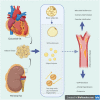Cardiorenal Fat: A Cardiovascular Risk Factor With Implications in Chronic Kidney Disease
- PMID: 34113631
- PMCID: PMC8185173
- DOI: 10.3389/fmed.2021.640814
Cardiorenal Fat: A Cardiovascular Risk Factor With Implications in Chronic Kidney Disease
Abstract
There is a growing interest in the potential role of adipose tissues in cardiac and renal pathophysiology, and determining the mechanisms by which fat compartments around the heart and kidneys influence cardiovascular disease is of clinical importance in both general and high-risk populations. Epicardial fat and perirenal fat have been associated with adverse outcomes in chronic kidney disease (CKD) patients. Epicardial fat is a rich source of free fatty acids and is capable of secreting inflammatory and pro-atherogenic cytokines that promote atherosclerosis through a local paracrine effect. Recent evidence has demonstrated that perirenal fat has a closer correlation with kidney diseases than other visceral fat deposits in obesity or metabolic disturbances. Moreover, perirenal fat has been reported as an independent risk factor for CKD progression and even associated with cardiorenal dysfunction. Accordingly, these forms of organ-specific fat deposits may act as a connecter between vascular and cardiorenal disease. This review explores the possible links between epicardial and perirenal fat and its significant role as a modulator of cardiorenal dysfunction in CKD patients.
Keywords: adipose tissue; cardiorenal disease; cardiovascular disease; chronic kidney disease; renal failure.
Copyright © 2021 D'Marco, Puchades, Panizo, Romero-Parra, Gandía, Giménez-Civera, Pérez-Bernat, Gonzalez-Rico and Gorriz.
Conflict of interest statement
The authors declare that the research was conducted in the absence of any commercial or financial relationships that could be construed as a potential conflict of interest.
Figures


References
Publication types
LinkOut - more resources
Full Text Sources

